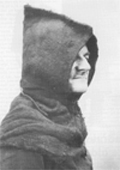 |
|
| Back to Start |
Gavlneset og Gavlen, at right, in sunset. Foto: Idar Nilssen. "Skjoldehamndrakten vender tilbake" Skjoldehamn costume returns Translated by Jennifer Bray More about the Skjoldehamn costume
|
| Aktuelt fra distriktet |
Presentations on Skjoldehamn Free Church
Skjoldehamn frikirke of Norway and
Scandinavia's oldest costume from this era.
|
| Tilbake til Andøy |

|
|
Presenters: Kjersti Åshagen, curator
at Andøymuseet - Museum North and Lars Erik Narmo, archaeologist and
archeology research manager at LOFOTR, Viking Museum at Borg in Vestvågøy.
|
|
| Short about the costume from Skjoldehamn: The costume from Skjoldehamn on Andøya - the context, research history and reconstruction By Lars Erik Narmo, archaeologist and research manager at Lofotr Viking Museum |
|
The costume from Skjoldehamn, referred to as “Skjoldehamndrakten” in Norwegian was found by peat cutting next to the farmhouses at Skjoldehamn on the southern part of Andøya. If you know where to see you can study the site passing by with the Hurtigruten or by visiting the location. The Skjoldehamncostume consist of a body with hood (kaprun), outer skirt (kofte), inner skirt (skjorte), trouses (bukser), a belt, foot wrappings (ankelkluter) and bounds (ankelsurringer), socs (lester) and shoes (sko). The body was wrapped in a carpet (teppe) knitted with beautiful bonds (band) and leather straps. The good preserved textiles and poorly conditioned body was soon dismissed as a resent crime in june 1936. The chief of the Police ordered the body to be reburied on the church yard at Bjørnskinn. Later, in the atumn the same year, the discovery was reported to Tromsø Museum. They believed the findings to be maximum 200 years old The famous Norwegian archaeologist Guttorm Gjessing visited the site year after and excavated the site some more. At the bottom of the bog of approximately one meters depth he found a knife handle of oak and remnants telling him the wrapped body to be buried on reindeerskin on top of 4 – 5 birch branches and covered by birch bark (never). In short Guttorm Gjessing published the Skjoldehamn costume as a late medieval costume, a Norse poor man buried in unfashioned clothing, probably deposited in the bog as a punishment due to a serious crime. Gjessings article in “Viking” from 1938 are the most up to date fully discussion of the costume from Skjoldehamn. The pictures of the museum caretaker at Tromsø Museum dressed in the costume are often sited in historical literature. However few studies based on the actual archaeological material has been published in the past 70 yeas. The costume from Skjoldehamn was deposited to be preserved at the University of Bergen, and still is. Because of the good state of preservation the details of this costume is of great interest to reconstructions of old/prehistoric suits – as Lofot Viking Museum. We wanted to do a detailed reconstruction but the published details were not sufficient. Luckily the MA student in archaeology Dan Halvard Løvlid at the University of Bergen got interest in writing a theses based on a new complete empirical study of the Skjoldehamn costume. A part of the process was experimental archaeology to reconstruct of the suit at Lofotr Viking Museum. We started the reconstruction process in 2008 and have used quite a lot of recourses on this up to this year. To finish the complete costume we have to continue the next year as well. This archaeological experiment is open to the public at Lofotr Viking Museum during the season and many handcrafters have helped Dan Halvard Løvlid to recreate the material, among them the textile worker Karin Sliper involved in the whole process up to now. When you got to know it the costume of Skjoldehamn is a fascinating story about prejudice in the research history (virkningshistorie) when it comes to ethnicity, gender and social position. Among other we now can date the costume to approximately 1050 AD. The Late Viking Age dating is 4 – 500 hundred years earlier to Gjessings interpretations 70 years ago, making the Skjoldehamn costume to the oldest existing complete clothing in Norway, and unique to the Viking Age from Scandinavia.
|
|
|
Helge Guttormsen wrote his history in the
history society’s yearbook for 1984:
Suddenly the spade cuts down at the feet of a corpse deep in the marsh. The body lay on 4-5 twigs from roughly hewn birch branches, 4-5 cm thick and approx. 50 cm long. Over these rods, which lay cross wise, lay the remains of a reindeer skin hair side uppermost. The body in its clothes was placed upon this. It was wrapped in a blanket bound in a bundle by thin leather straps and narrow woven ribbons. Over everything lay a layer of birch bark. Further measurements showed this birch bark layer was 87 cm below the surface, with the rods probably at a depth of 20-30 cm deeper. The body laid on the left side, sloping to the north, according to the finder, Richard Olsen. The knees were pulled up, the right arm stretched down to the knees and the head was probably facing left. The finder of the body believed that there was a 5 inch fracture on the skull and the brain mass was barely preserved, a reddish stain could be seen through this break in the skull. Did a blow from an axe cause this burial?
At Tromsø Museum it was believed based on the information that was available, that this was a folk costume from the 17-1800s. The farmer Hans Liavik was therefore asked to dig the remains of body and clothing from the marsh, pack it well and send it to Tromsø. However, as soon as the find finally arrived in Tromso in November 1936 it was realized that the costume was a find of significance not just in North Norway, but also in a wider Norwegian and Nordic context. Here was the first discovery of a medieval
costume in Norway, and one known only in other Nordic countries from a few
items from Denmark, and several from Greenland.
|
|
|
|
The find was made in southern
Skjoldehamn, in Gavlen on the border of the farm Skjolde.
Lars Erik Narmo giving details of the
newer research and the work of reconstructing the Skjoldehamn costume.
Kjersti Åshagen, left., and Trine
Adolfsen from the Viking Museum, show the reconstructed costume.
Detail of outer skirt
The hood was made up of several parts,
probably woven in four shaft twill (like the rest of the suit) in natural
brown colored wool. Båndene på drakten er grindvevd. Bildet viser en "båndgrind" utlånt fra Museum Nord. (Klikk på bildet for forstørrelse). Foto: Idar Nilssen.
The sleeves of the costume have bands
woven with a rigid heddle
The trousers’ lower edge is decorated
in the same way.
The Tunic also had trim around the neck.
There have been discussions about the
shoes, but it seems that it's all about moccasins.
The suit was equipped with multiple
woven straps.
|
|
The speech drew more than 60
listeners. Here, the audience
One saw both the old and the very young in the audience. Photo: Idar Nilssen.
Listeners to Kjersti Åshagen ho was amongst the presenters. The local newspaper sent Alf Ragnar Olsen, Trine Adolfsen, Lars Erik Narmo, Marianne Pettersen and historian Johan Borgos. Photo: Idar Nilssen.
It was an attentive audience that followed talks about an unusual interesting topic. Many took the opportunity for questions and comments. Photo: Idar Nilssen.
Newfangled devices. An archaeologist and a museum curator,
Lars Erik Narmo and Kjersti Åshagen, preparing for the use of aids from a
different time than those concerned with their jobs.
These three ladies provided catering, coffee and waffles. From the left: Annbjørg Kristiansen,
Jorunn Fjeld Nilsen and Solveig Nordback.
|
|
|
The find site A later picture of the site in the marsh just south of the Free Church. It used the old image of Guthorm Gjessing in 1937 as a guide. In addition, the site marked on the newer versions of Økomomisk maps. Yet it was necessary to resort to GPS navigation to find the point that is registered.
This is one of the pictures Guttorm Gjessing took in 1937, the year after the discovery was made. It catches sight of Frikirken at the
right edge of the picture and the house of Hamansen is in the middle of the
picture. Peat piles hide some of the terrain above the
The area looks a little different in 2009. The photographer had to stand a little further south than Gjessing because of the forest that grown up since. One can no longer see Frikirken but Hamansenhuset is still there. The find site according to the map reference recorded is indicated by arrows. Photo: Idar Nilssen.
This photo was taken in a slightly more northerly direction. One can glimpse the roof of the Frikirken, and you still have peat about 15 meters further west. This probably happened before 1953. Photo: Idar Nilssen.
The search for "the scene". Many braved the nasty weather in search of the site. Photo: Idar Nilssen.
Oddmund Pettersen was only 6 years
old when the discovery was made.
|
|
|
What happens in the future? A bit about reconstruction of the Skjoldehamn costume. v / Lars Erik Narmo, research manager at Lofotr Viking Museum 1. October 2009
Many, however, have supposed much about
the costume or its parts on the basis of what is published - without having
seen it for themselves. The need for empirical review of the primary
material was the basis for the reconstruction of Skjoldehamn costume the
Lofotr Viking Museum. In collaboration with AHKR - Department of Archaeology,
History, Cultural Studies and Religion, University of Bergen, we found Dan
Halvard Løvlid who wanted to write a master's thesis on textiles. After
agreement on access to the costume from Tromsø Museum Løvlid’s work on the
Skjoldehamn costume was established asthe subject for a Masters thesis in
archeology. The
reconstruction of the costume was conducted at Lofotr Viking Museum. Dan
Halvard Løvlid led reconstruction efforts in the longhouse through two
seasons. The work was not completed within the year and therefore the
reconstruction extended into a third season. The work of reconstruction has
been open to the public. Lofotr Viking museum had about 67,000 visitors in
2008, the number of visitors is similar this year. The Skjoldehamn costume
is thus conveyed to many - in languages like Russian, Polish, Italian,
French, English, German etc.
|
|
| Tilbake til Andøy | Tilbake til oversikten |